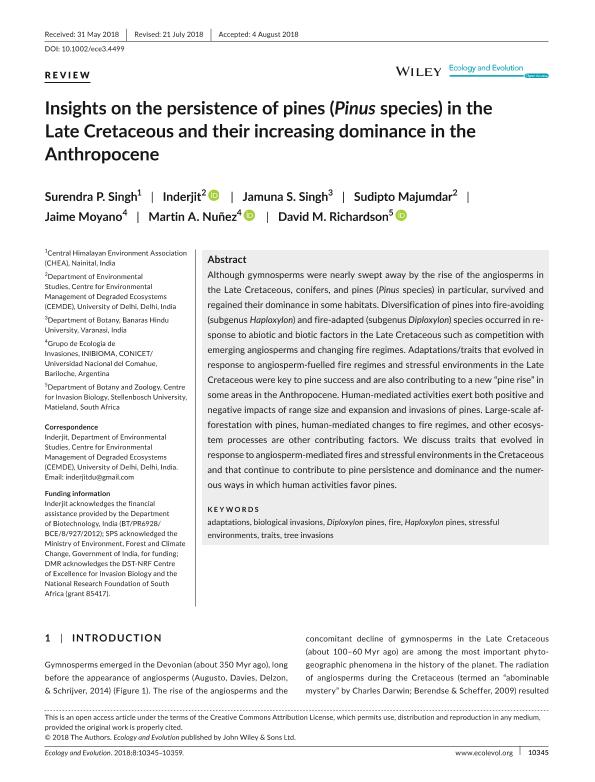Artículo
Insights on the persistence of pines (Pinus species) in the Late Cretaceous and their increasing dominance in the Anthropocene
Singh, Surendra P.; Inderjit ; Singh, Jamuna S.; Majumdar, Sudipto; Moyano, Jaime
; Singh, Jamuna S.; Majumdar, Sudipto; Moyano, Jaime ; Nuñez, Martin Andres
; Nuñez, Martin Andres ; Richardson, David M.
; Richardson, David M.
 ; Singh, Jamuna S.; Majumdar, Sudipto; Moyano, Jaime
; Singh, Jamuna S.; Majumdar, Sudipto; Moyano, Jaime ; Nuñez, Martin Andres
; Nuñez, Martin Andres ; Richardson, David M.
; Richardson, David M.
Fecha de publicación:
10/2018
Editorial:
John Wiley & Sons Ltd
Revista:
Ecology and Evolution
ISSN:
2045-7758
Idioma:
Inglés
Tipo de recurso:
Artículo publicado
Clasificación temática:
Resumen
Although gymnosperms were nearly swept away by the rise of the angiosperms in the Late Cretaceous, conifers, and pines (Pinus species) in particular, survived and regained their dominance in some habitats. Diversification of pines into fire-avoiding (subgenus Haploxylon) and fire-adapted (subgenus Diploxylon) species occurred in response to abiotic and biotic factors in the Late Cretaceous such as competition with emerging angiosperms and changing fire regimes. Adaptations/traits that evolved in response to angiosperm-fuelled fire regimes and stressful environments in the Late Cretaceous were key to pine success and are also contributing to a new “pine rise” in some areas in the Anthropocene. Human-mediated activities exert both positive and negative impacts of range size and expansion and invasions of pines. Large-scale afforestation with pines, human-mediated changes to fire regimes, and other ecosystem processes are other contributing factors. We discuss traits that evolved in response to angiosperm-mediated fires and stressful environments in the Cretaceous and that continue to contribute to pine persistence and dominance and the numerous ways in which human activities favor pines.
Archivos asociados
Licencia
Identificadores
Colecciones
Articulos(INIBIOMA)
Articulos de INST. DE INVEST.EN BIODIVERSIDAD Y MEDIOAMBIENTE
Articulos de INST. DE INVEST.EN BIODIVERSIDAD Y MEDIOAMBIENTE
Citación
Singh, Surendra P.; Inderjit; Singh, Jamuna S.; Majumdar, Sudipto; Moyano, Jaime; et al.; Insights on the persistence of pines (Pinus species) in the Late Cretaceous and their increasing dominance in the Anthropocene; John Wiley & Sons Ltd; Ecology and Evolution; 8; 20; 10-2018; 10345-10359
Compartir
Altmétricas



